NRA National Cycle Network needs to be set aside and the 2007 Fáilte Ireland Cycle Strategy reinstated.
One of the key recommendations in our submission on the recent Greenway Strategy Consultation was for the 2010 National Roads Authority (NRA now TII) National Cycle Network (NCN) proposals to be set aside. (We also called for TII to be removed as a lead agency in the provision of long distance cycling routes.) This is an important topic that needs a separate article to itself. The story of the NCN proposals shows how various interests might seek to hijack cycling policy for their own ends. The content of the NRA/TII proposals raises questions about the attitude of those involved to civil society, suggests an active attempt to avoid and evade the policy it was supposed to be delivering, and raises questions about the authors’ understanding of the legal frameworks governing Irish roads. Predictably the NRA proposals have failed to deliver attractive routes. Most worryingly it seems those drafting the current DTTaS Greenway Strategy proposals are using the poor performance of the NRA approach as a pretext to avoid implementing the recommendations of the 2007 Fáilte Ireland Strategy for the Development of Cycling Tourism and the 2009 National Cycle Policy Framework.
Background
The 2009 National Cycle Policy Framework (NCPF) was seen as a game changer for cycling in Ireland and as a realistic well-considered blueprint showing the way forward for cyclng policy. The NCPF included a policy objective for the creation of a National Cycle Network.
The network identified will mainly use a mix of minor roads, and some greenways. The greenways are especially important for, typically, the first 10km along the routes emanating from busy town centres which are heavily trafficked and particularly unattractive for inexperienced or very young cyclists.
NCPF Proposals themselves were to be based on the 2007 Fáilte Ireland Strategy for the Development of Irish Cycle Tourism. Like NCPF the tourism strategy involved extensive consultation. The Fáilte Ireland document included the use of minor low-traffic country roads and lanes as a fundamental part of their proposed cycle network.
“Much of the proposed Irish Cycle Network route will utilise the network of country lanes and roads throughout the country. These roads have been chosen where traffic levels are light and lanes have a line of green grass up the centre rather than white paint!”
In addition, the Fáilte Ireland document states explicitly that busy R and N roads are to be avoided “Generally due to high traffic levels and high speeds we wish to avoid cycling on N or R-roads”. What appears to have happened then is that the National Cycle Network aspect of the NCPF was allocated to the National Roads Authority (NRA) – now called Transport Infrastructure Ireland (TII). In 2010 the NRA produced the National Cycle Network (NCN) Scoping Study.
The National Cycle Network “stakeholders”: the first warning signs
Before considering the content of the NCN document the way it was put together should have had alarm bells ringing. The 2010 NCN document lists 15 stakeholders. It also states that there was detailed engagement with those stakeholders. But the list contains only state actors. There are no representatives of cycling interests, rural development interests, farming interests, or community structures such as community fora. The 2010 NCN document was apparently compiled by a steering group that did not consider the community as stakeholders in an NCN project. This shows a poor attitude to civil society. It is difficult to see how a program drafted and proposed with such an attitude could hope to be successful. This should also be contrasted with the detailed consultation that went into the National Cycle Policy Framework and the Failte Ireland Cycling Strategy. Both those documents listed cycling organisations as members of future steering groups or implementation structures.
A departure from the cited sources.
The final NRA National Cycle Network document proposed a network of approximately 2000km based on corridors linking major cities and population centres of over 10,000. The authors state that they are not defining the final route nor indicating the final “standard” of provision. The authors define four route types or classifications.
- Cycle lanes (on-roadway cycle tracks)
- Two-way cycle lanes (on-roadway cycle tracks) within the same road surface
- Roadside cycle paths (off-roadway cycle tracks)
- Cycle trails (“Cycleways” in Irish legal terminology)
(The terms used in the NRA document were different and did not comply with the legally defined terminology in Ireland – there is a note at the end of this article explaining the problem and its implications for the understanding of the NCN authors)
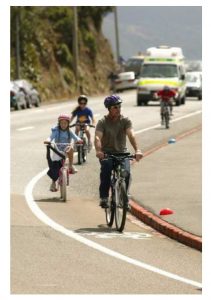
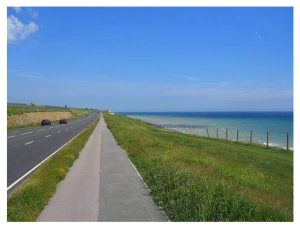
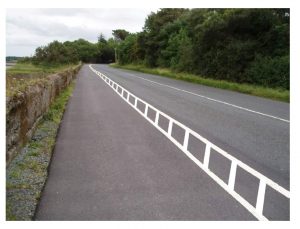
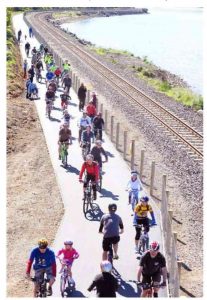
The illustrations for the four route type classifications in the NRA National Cycle Network proposals. Three of them show cyclists placed directly beside motor traffic on main roads – including an interurban dual carriageway. There is no mention of using low-traffic country lanes and boreens.
The pictures illustrating the road-side treatments show that people on bicycles would put right beside motor traffic on R or N type roads including an interurban dual-carriageway. This is against the general vision of the Fáilte Ireland strategy recommendations: “National or N-roads are not, generally, recommended as forming part of a National Cycling Network. As with the R-roads, traffic levels are higher with many carrying significant volumes of Heavy Goods Vehicles (HGV’s) and tour coaches.” There is no mention anywhere in the NRA document of using minor low-traffic rural lanes and tracks as a component in the proposed network. Although the NCN references the Failte Ireland Strategy and the NCPF its recommendations seem directly opposed to the vision of both documents. The authors refer to the Fáilte Ireland Strategy as being “primarily an on-road” network but make no reference to the types of roads that were being considered by the Strategy or by the NCPF. Rather than being a way forward, the proposals in the 2010 NRA document invite speculation that they were intended to avoid and undermine the guiding policy documents and to avoid best practice in the provision of rural cycling routes. Overall the 2010 NCN document appears to have been drafted by a group of regional roads engineers for the purpose of justifying engineering works involving R and N roads. Arguably, this was exactly what the NCPF and the Fáilte Ireland Cycling Strategy were trying to avoid.
What effect have the NRA National Cycle Network proposals had?
The 2017 Greenway Strategy Consultation discusses the schemes that were funded under the NRA NCN proposals. The consultation document states that “The [NCN] Study was, however, referenced in the funding calls launched by the Department in 2012 and 2014. However, the on-road projects awarded funded under these funding calls have not proven to be as successful as those that were off-road or predominantly off-road, i.e. greenways.” The greenway consultation paper provides a list of schemes approved for funding under the National Cycle Network heading and sections of it make for depressing reading. In 2012, five of the schemes appear to have involved marking cycle lanes or “cycle tracks” within the hard shoulders of existing roads. Even worse it appears the obvious flaws with the NRA NCN approach are being used as a pretext to turn away from the approach in the Fáilte Ireland Strategy and the National Cycle Policy Framework.
Hard shoulders – already a type of (limited) cycle facility
Before examining the effect of the NRA’s NCN vision a quick note is needed on hard shoulders and cycling. Hard shoulders are already acknowledged as a type of cycling facility in Ireland and elsewhere. The arterial nature of the traffic and traffic speeds on most Irish roads with hard shoulders generally makes them unsuitable locations for child cyclists or less confident adults. However, they have an established value for more confident adult cyclists. Hard shoulders attract occasional use as a slow lane by motorised traffic. Some cyclists are uncomfortable with this; however it has the side-effect of sweeping any debris to the side of the road. Hard shoulders stay “usable” as a cycle facility because they are naturally “swept” from time to time. Hard shoulders also tend to be wider.
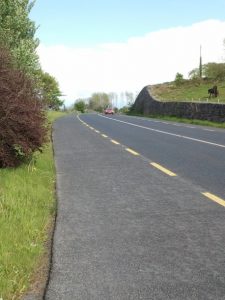
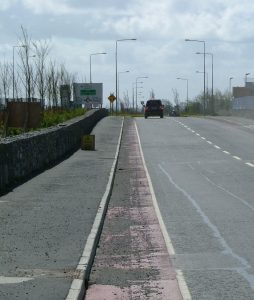
In Ireland and elsewhere hard shoulders are already considered a type of cycle facility – in the absence of maintenance – they are less likely to accumulate debris and more likely to stay usable than cycle lanes.
Hard shoulders on Irish national routes have provided a huge rural cycling infrastructure. A 1975 An Foras Forbartha report on cycling included this finding “Hard shoulders on national primary routes reduce cyclist accident rates by as much as 50%”. Hard shoulders are a practical rather than ideal solution – even so the extra space improves safety and comfort, and roads with hard shoulder are often arguably safer, more comfortable and more attractive cycling environments than the main roads in the urban centres they connect.
An example of one of the NCN schemes – the R420 (N80) in Offaly
One of the schemes funded under the NCN budgets involved the former N80 (R420) in County Offaly running north from Tullamore towards Clara and Moate. The road already had hard shoulders for much of its length. The scheme was budgeted to cost €400,000 with approximately 14km of the route “on road” and approximately 3km north of the village of Tober to be “off-road”.
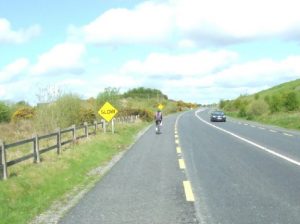
Illustration from the Offaly County Council 2012 NCN Funding application showing what the road already looked like.
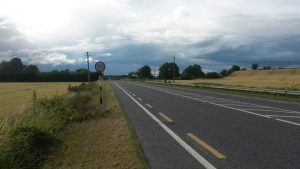 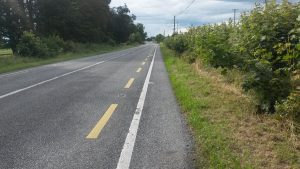 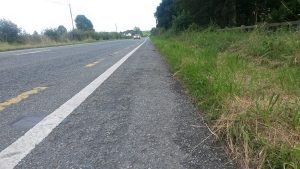 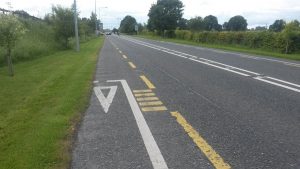 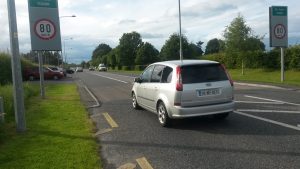 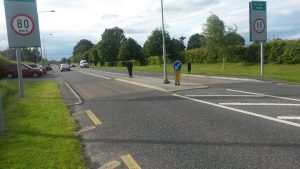 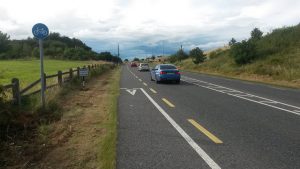 |
Photos of the scheme from Tullamore to Tober: New lines painted in existing hard shoulders, inexplicable yield markings, new upright cycling route signs, speed limits unchanged from 100km/h, a cyclist hostile pinch point at Tober left in place unchanged.
Looking at the section from Tullamore to Tober it is difficult to see any real net benefit for cycling. Marking cycle lanes in hard shoulders does nothing to address the nature of the traffic using the roads. It does nothing to increase the overall length of cycle network of that character. Worse it may create a false expectation of safety and attract novice cyclists to a route that is fundamentally unsuitable to their needs. It may also have the side effect of reducing the cleaning effect that was keeping them usable for cyclists. All these issues were established prior to 2012 when cycling interests had already raised serious reservations about marking cycle lanes in hard shoulders. Cycling hostile features such as the pinch point at Tober remain in place. This undermines claims that the intent of these works was to benefit cycling.
The 3km section north of Tober shows more of an attempt at what might be considered a recreational route for tourists or family groups. An attempt has been made in places to build a cycle path well to the side of the main road. However some sections are still right beside the road and with flexible red wands along the boundary. In terms of protection from motor vehicles moving at 100km/h they might be little better than a line of paint.
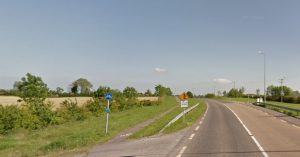 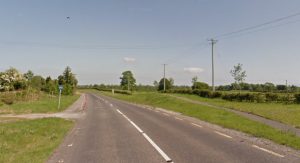 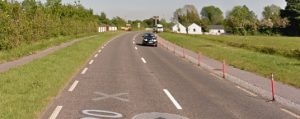 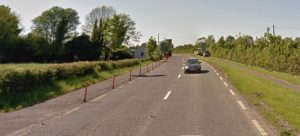 |
Google street-view screen-grabs showing the NCN section north of Tober
However the elephant in the room is how would these tourists or family groups get to this section of the R420? The route from the south involves the road we have already described. The route from the North involves coming through the roundabouts at Junction 6 of the M6 motorway. Because this is where this section of the NCN would begin. The presence of these roundabouts makes this a wholly unsuitable location for recreational cyclists. As a result, the presence of an unchanged Junction 6 destroys the credibility of this scheme as being a component in a National Cycling Network. (See note on Roundabouts at the end of this document)
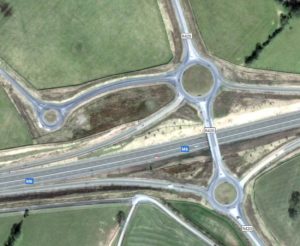
Junction 6 on the M6 motorway: the northern starting point for this section of the NCN
Summary
To sum up for informed bicycle users looking at the situation, a general practice of marking cycle lanes in hard shoulders is at best a profoundly misguided and at worst a straightforwardly cynical use of public money. Discontinuous sections of off-road cycle path on arterial national routes attract the same criticism. These NCN schemes have the unfortunate appearance of projects created by roads authority engineers for the purpose of consuming state cycling budgets for no net benefit. If these schemes then failed to provide a more generally suitable cycling environment this is not an argument for of focusing cycling budgets exclusively on greenways, it is an argument for improved governance over the manner in which the DTTaS spends tax payer’s money. Most disturbing, it seems that the poor performance of these NRA NCN schemes is being used as a pretext to dismiss other types of on-road solutions and by extension to dismiss the 2007 Fáilte Ireland Cycling Tourism Strategy and the National Cycle Policy Framework.
A final note on terminology
In the 2010 NCN document the authors make confusing use of terminology. In Ireland, the terms “cycleway” and “road” are very clearly stated and defined under the Roads Act. The full definitions are provided below. To put it simply in Irish law a “cycleway” is a stand-alone road dedicated to cyclists or cyclists and walkers and from which other traffic is excluded. The Galway Cycling Campaign also possesses a legal opinion to this effect. The Irish Traffic Regulations define cycle facilities within other roads as “cycle tracks”. Cycle tracks can be on-road* (cycle lanes) or off-road* (road-side cycle paths). In the 2010 NCN document, the term “cycleway” is used interchangeably to describe cycle facilities within other main roads and placing cyclists in close physical proximity to high speed traffic. The study authors then use the term “cycle trail“ to indicate what are termed cycleways in Irish law. It appears that at best the authors (from the National Roads Authority) did not understand the legal frameworks governing Irish roads. Whatever the reason, the NRA document uses terminology in a manner that might tend to confuse readers about what was being proposed.
* A better way to express this is “on-roadway” or “off-roadway” as in traffic law the roadway is the part of the road normally reserved for vehicles. The footway is what is generally called the “footpath”. Both the roadway and the footway are part of the road.
Appendix Legal Definitions
ROADS ACT, 1993 Section 68: Cycleways
68.—(1) In this section “cycleway” means a public road or proposed public road reserved for the exclusive use of pedal cyclists or pedal cyclists and pedestrians.
( 2 ) ( a ) A road authority may construct (or otherwise provide) and maintain a cycleway.
( b ) Where a road authority constructs or otherwise provides a cycleway it shall by order declare either—
(i) that the cycleway is for the exclusive use of pedal cyclists, or
(ii) that the cycleway is for the exclusive use of pedal cyclists and pedestrians.
( c ) Any person who uses a cycleway in contravention of an order under paragraph (b) shall be guilty of an offence.
ROADS ACT, 1993 Interpretation
“road” includes—
(a) any street, lane, footpath, square, court, alley or passage,
(b) any bridge, viaduct, underpass, subway, tunnel, overpass, overbridge, flyover, carriageway (whether single or multiple), pavement or footway,
(c) any weighbridge or other facility for the weighing or inspection of vehicles, toll plaza or other facility for the collection of tolls, service area, emergency telephone, first aid post, culvert, arch, gulley, railing, fence, wall, barrier, guardrail, margin, kerb, lay-by, hard shoulder, island, pedestrian refuge, median, central reserve, channelliser, roundabout, gantry, pole, ramp, bollard, pipe, wire, cable, sign, signal or lighting forming part of the road, and
(d) any other structure or thing forming part of the road and—
(i) necessary for the safety, convenience or amenity of road users or for the construction, maintenance, operation or management of the road or for the protection of the environment, or
(ii) prescribed by the Minister;
Roundabouts
Source: R.286 Design and Use of Roundabouts in Ireland, An Foras Forbatha, 1987.
In R286 the most relevant study is one that takes an in depth look at traffic accidents on the roundabouts on the Swords bypass in Dublin. A particular finding was that the accident rate for the two-wheelers was five (x5) times higher than they were expecting.
Section 4 General Observations on Specific By-Pass Accident Groupings
Page 95:
” (d) One of the worrying features of the safety performance of the Swords By-pass is the high incidence of two-wheelers in personal injury accidents (over 50% of all injury accidents as shown in Table 5). Significantly this trend reflects that of the T.R.R.L. report where accident involvement rates […] of two-wheeler riders were about 10-15 times those of car occupants. Comparative Irish figures of fatal and injury accidents for pedal cycles and motorcycles outside build up areas are 4.6% and 6.8% respectfully. Thus the combined rate is approximately 20% of that for the By-pass accidents”
Section 5 Conclusions
Page 101
“4) The high incidence of two wheeler accidents on the Swords bypass allied with similar findings in the major accident study carried out by the TRRL on roundabouts shows that roundabouts on high speed roads do not provide a safe environment for two wheelers and consequently give serious reservation as to their use where high numbers of this road user class is expected”.
Source: National Cycle Policy Framework 2009
Page 20 Section 2.6 Remedial Measures
We will carry out remedial measures on existing cyclist-unfriendly urban roads with a special focus on roundabouts, multi-lane oneway streets and road narrowing schemes. Without addressing the difficulties posed by high capacity, high speed roundabouts in urban locations – and particularly those between residential areas and schools – it will be very difficult to encourage more of the public to cycle.
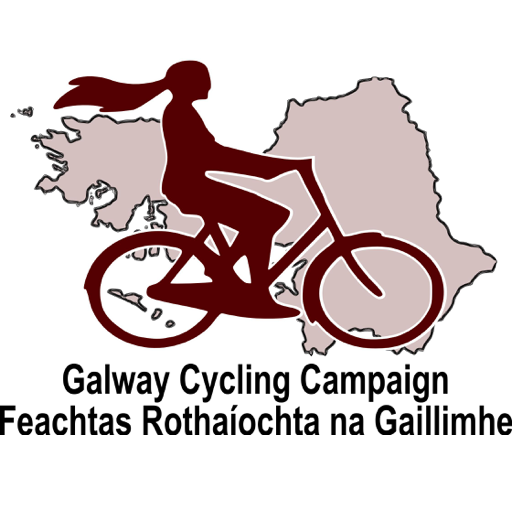
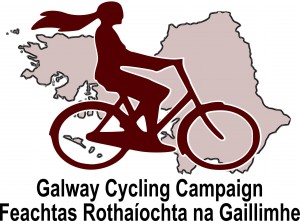
Leave a Reply